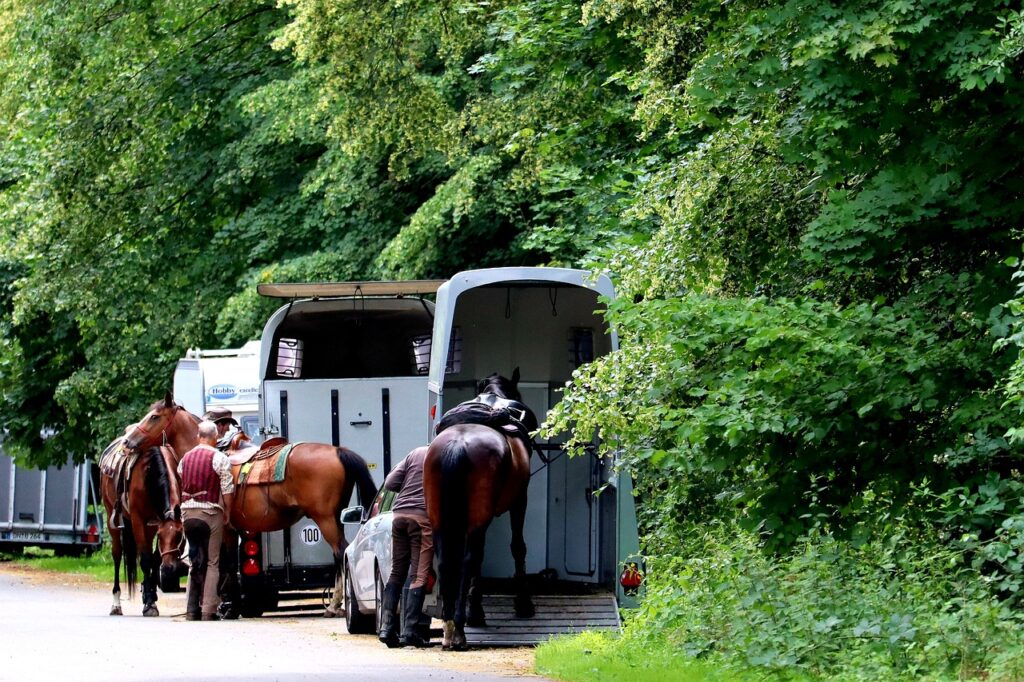4 Essential Rules for Trailering Your Horse
Yup – that’s right, I said RULES for trailering horses.
Not guidelines, not suggestions, not even recommendations. Because you’re taking on a huge responsibility!
You’re asking a prey animal to climb into a dimly lit, noisy, closed, metal box. He has to trust you with his life! Can you even imagine how completely insane that must seem to the horse? That’s why these are rules, and they are so important.
This post is for you if you:
- Have been hauling or trailering horses for years
- Are a professional horse hauler
- Are teaching your teenager how to pull the horse trailer
- Are a new horse and trailer owner
You have precious cargo to protect as you go down the road! For you hauling veterans, these are excellent reminders. For newbies, this is a must-read!
Rule #1: Hook Up Your Own Trailer
It’s your horse, your trailer, your responsibility. Never leave that up to someone else.
Don’t get me wrong, it’s totally great to have help getting your truck hooked up to your trailer. But YOU should always have the last look. Whenever possible, YOU should be the one to lock the hitch pin, hook the safety chains, and connect the emergency brake cable.
Create a habit to double-check your connection each time before you climb in the truck. For example, I always pause to look over the bed rail after fueling stops, bathroom breaks, etc. Make sure everything looks the same as when you hooked it up.
Rule #2: Maintain Your Trailer
Some people are sticklers about trailer maintenance. I have a friend who grew up showing. Her father was an AQHA board member, so they showed and traveled nearly every weekend. She remembers that after every trip, the trailer must be spotless – inside and out!
That’s a lot of work, but not a bad habit – if you have that kind of time and energy. While it’s great to keep a shiny trailer, there are more important things to maintain for safety’s sake. Here are some guidelines:

Annual (or more often depending on miles hauled)
Each year, I take my trailer to a person who repairs horse trailers. Not an auto mechanic. This person knows horse trailers.
Annual maintenance includes:
- Inspecting the wheels, axles and brakes, and undercarriage of the trailer, and making necessary repairs or replacements.
- Repacking the wheel bearings and
- Greasing everything that needs greasing
- Checking/fixing/replacing the lights and electrical connections
- Checking and potentially replacing the emergency brake (breakaway switch)
Semi-Annual (or more often…)
Twice a year, I pull the rubber mats out of my trailer and give the inside floor and walls a good scrubbing. Depending on your trailer’s flooring, you might need to check for and treat corrosion or rotting wood.
At least semi-annually, I inspect the tires to make sure they are wearing appropriately. A trusted tire professional shouldn’t mind helping you with this task (especially if you purchased your tires from them).
Though I try to do it more often, I wash and treat my trailer’s exterior at least twice a year. If I can afford it, I take it to a professional. But it’s not hard to DIY. Personally, I love the Streak Master products. Not expensive and super easy to use with amazing results!
Every Trip
Before:
- Check the tire pressure and add air if needed
- Check that the lug nuts on all the wheels are tight (had a friend watch one of her wheels pass her one time…)
- Check that all latches securely fasten and don’t have any loose screws or hinges
True story – I had a window fall off going down the highway. Thankfully, it didn’t hit anyone else on the road. Those aren’t cheap to replace.
After:
- Clean the manure and loose hay from the inside of the trailer (helps maintain flooring)
- Again, check the lug nuts and latches
- If you have time, rinse the dust off the outside of the trailer
Rule #3: Train Your Horse to SAFELY Load and Unload
There’s nothing more frustrating than needing to go somewhere, and your horse refuses to load up. A friend once had a colt who refused to UNLOAD from her trailer! That horse stood in the trailer for nearly 2 days before he finally gave up and came out.
In my opinion, if you’re going to have a horse, it needs to load and unload calmly, quietly, and safely. There’s really no excuse for not training your horse to load and unload safely.
My foals take several trailer trips with mamma before weaning. Then, trailering horses becomes part of the post-weaning program, just like learning to lead, picking up their feet, etc. They learn quickly and easily that it’s no big deal.
Maybe you’ve acquired a horse that isn’t trailer broke. It’s best to get that issue resolved quickly! He will need to go somewhere at some point. If you’re unsure how to train your horse to load and unload, there are lots of YouTube videos from professional horsemen/women or find a trainer near you to help.
Just remember, just like every other skill your horse learns, he won’t just “get it” overnight. It’s going to require patience, consistency, and lots of positive practice and reinforcement.
Rule #4: Be Prepared for Every Trip
If you read rule #1, then you’ve done the hitching and pin locking yourself. So you’ve noted that your trailer tongue and hitch ball are secure. Let’s take a look at what else you should be prepared for.
Tires
FACT: You will have a blowout and be stopped on the side of the road at some point. It happens to all of us sooner rather than later. Here are some pointers to help you be as prepared as possible.
Have the Right Tires for Your Trailer
- Never use tires designed for cars (LT) or trucks on a horse trailer
- Pay attention to the load capacity rating marked on the tire. According to tires-easy.com, load range, which is the maximum weight a tire is engineered to carry when properly inflated, is indicated by a letter (C thru F), which corresponds to the “ply.” For example, C=6 ply, D=8 ply, E=10 ply, F=14 ply, etc. The higher the ply rating, the higher the load capacity of the tire.
- Work with a trusted tire dealer, preferably one who knows horses and horse trailers, to determine the best tires for your rig.
- Always go with a quality, reputable brand of horse trailer tires
Carry 2 Spares. At. All. Times.
I’ve had to use both spares 3 different trips. And as soon as possible, yes – at the very next town large enough to have a tire shop, I replaced both tires and put the spares back in their storage places!
During one trip, both tires blew at the same time, on the same side of the trailer. Which leads me to my next point.
Carry Tire Changing Equipment
- A Jiffy Jack
- Consider investing in a battery-powered impact wrench and socket set (this really speeds up the process of removing and replacing lug nuts!)
- Consider carrying a floor jack or heavy-duty hydraulic jack
When both tires blew on the same side, of course, my Jiffy Jack wasn’t going to work. Thankfully, a knowledgeable Good Samaritan stopped to help. He pulled out his floor jack, lifted the trailer, and with the help of that battery-powered impact wrench (his AND mine), we had the tires changed in no time! Now I carry a hydraulic bottle jack.
Invest in a Roadside Assistance Service
Roadside assistance comes in handy whether you have a blowout, breakdown, or simply lock your keys in the truck. It’s all happened to me, and it will probably happen to you.
But – BUYER BEWARE! Ask your provider this question, “Will you help me if I’m towing my horse trailer with horses inside it?”
Many services, including the well-known AAA, likely will not help if you have live animals in your rig. They don’t want the liability. While those services may change a tire or open a lock, they will not tow your rig with animals inside. Be sure to ask!
Consider a service that’s specific to people hauling or trailering horses, like US Rider or Trailguard. It’s definitely worth the cost, and they will also help you when you’re not hauling.
Know Your Route
No matter where you’re going, remember you have a big, long box containing precious cargo tailing behind you. It’s critical to know BEFORE you go that the roads, towns, destination driveways, gates, and parking lots can accommodate your rig.
For example, the first time I went to an event at the beautiful Circle T in Hamilton, Texas, I was so thankful to have called in advance. Melanie, who manages the arena, was thoughtful enough to prepare me for the right-hand turn from the Hamilton town square onto the highway to the arena.
“Make sure you take a super wide approach!” She said. “You’ll need most of the three lanes, and you’ll block traffic a bit, but people are used to it.”
Whenever possible, choose roads, routes, and times of day that will help you stay calm when you’re hauling.
Watch the Weather
Even that quick trip to the vet gets sketchy in a pouring down thunderstorm. Pay attention to the weather when you are planning a trip with horses. Pulling a trailer on slick, or worse – icy roads is no fun!
Conclusion
Being able to confidently go places with your horse takes time and practice. The more you haul, the easier it gets, as long as you’ve paid attention to the rules.
Four rules aren’t hard to remember, and these rules will save you money, time, and heartache.
Stay tuned to this blog. We’ll have more to talk about regarding hauling and trailering horses, because well, we love to go places!
For now, safe travels!
What’s your experience (good, bad, and ugly) with hauling or trailering horses? We all learn from experience. Share your stories with us!


